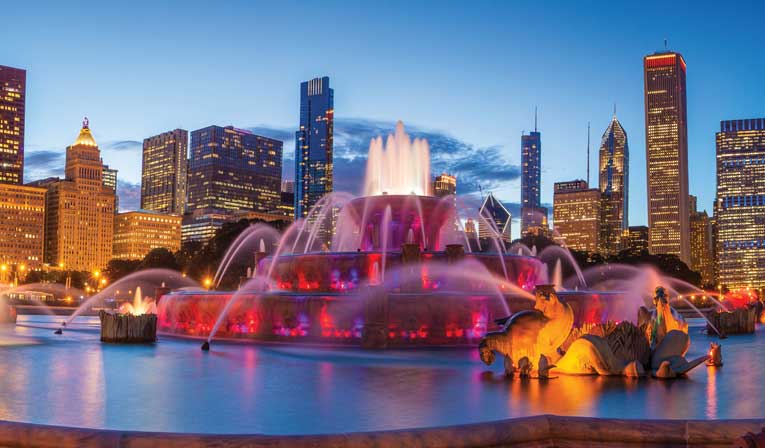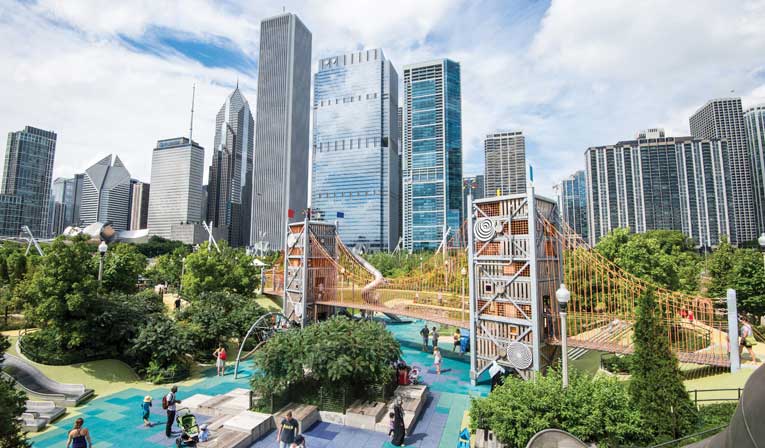Photo Courtesy of choosechicago.com
Chicago, Illinois is more than just the Cubs and White Sox, skyscrapers, tasty deep-dish pizza and the city’s notorious wind. Thanks to waterfront development, riverfront revitalization and endless activities, the “Second City” is a true Great Lakes destination.
Chicago’s skyline from Lake Michigan is breathtaking, especially as the sun begins to dip, silhouetting the city’s many skyscrapers. Visiting boaters could be tempted to spend all their time anchored out on the lake, drinking in the city’s beautiful architecture from a distance.
However, that would be a mistake.
Chicago’s working class roots have built a town known for its architecture, vibrant comedy scene, lovable sports teams and diverse dining, among other things. History plays an essential part in forming the city’s identity as well; you’d be hard pressed to find a Chicagoan who doesn’t know about the Great Chicago Fire of 1871, the World’s Fair of 1893, or the construction of the (for a while) world’s tallest skyscraper, the Sears Tower (now Willis Tower).
Today, visitors can become Chicagoans for a weekend and get a glimpse of the city’s rich history and culture by boat. On the lakefront, boaters can revel in Chicago’s young and energetic boat scene by rafting up with friends and exploring downtown. The Chicago River cuts through the heart of the city, offering boaters an intimate view of glass and steel (not to mention access to the finest restaurants and bars). Farther north or south from the main hub of activity, boaters can tie up at neighborhood marinas for a more local feel.
The lake: Open and spacious
Chicago sits on the southwest bottom corner of Lake Michigan. Boaters will find 10 harbors along the lakefront, many of which offer transient slips for those passing through. While this means there’s plenty to explore, boaters looking for a good open-water experience near the main downtown area should focus on four main options.
One of the most iconic options is Monroe Harbor, which sits directly across Lakeshore Drive from Chicago’s Grant Park. The open park area hosts a number of festivals during the summer, such as Rib Fest, Taste of Chicago and Lollapalooza. Docking at Monroe Harbor might be a good option for those who have never been to Chicago and want to see the city’s most famous sights, such as Cloud Gate (fondly dubbed “The Bean”), the Buckingham Fountain, the Chicago Art Institute and the Magnificent Mile. Monroe Harbor is also home to the Chicago and Columbia yacht clubs.
Just north of Monroe Harbor is the smaller DuSable Harbor; in fact, boaters must pass through Monroe Harbor to reach DuSable. As with all Chicago harbors, boaters can submit reservations for transient docking through the Dockwa app (dockwa.com).
Sports fans might consider Burnham Harbor, which is within walking distance to Soldier Field, home of the Chicago Bears. The city’s largest harbor is located off a spit of land called Museum Campus. Boaters with families might enjoy treks across the campus to Adler Planetarium, Shedd Aquarium and Field Museum.
Burnham is tucked between the city and a man-made peninsula named Northerly Island, which boasts a fairly new outdoor concert venue. If the breeze is just right, boaters can anchor outside Northerly Island for some free tunes.
Enza Montano, a spokeswoman for Chicago Harbors, suggests boaters also take a trip farther south to the city’s newest harbor, 31st Street Harbor. This eco-friendly marina has it all, including transient dockage, a floating swimming pool, restaurant and full bar.
“It is also home to one of the city’s best children’s play lots and has a beach, so it’s a family favorite,” Montano says.
HarborFest, a two-day music festival and boat show, is now held each year at 31st Street Harbor in June.
Boaters looking to hang out with the younger crowds during the summer months should cruise over to the “Play Pen,” a seawall-protected area just north of Navy Pier. The area becomes crowded and easy to spot on weekends with boats rafting up for parties on the water; just listen for music and shrieks from the brave souls who decided to jump into Lake Michigan’s perpetually cold waters.
There’s plenty to explore for those who would rather avoid the party boat scene. When Chicagoans refer to “the Lakefront,” they mean more than Navy Pier and the marinas nearby. Boaters can tie up and walk or rent out Divvy bikes along the 18-mile-long lakeshore path, which connects the city’s 26 beaches.
Montano also emphasizes the beauty of the lakefront at night: “Especially on Wednesdays and Saturday evenings, from Memorial Day to Labor Day, when the city has firework shows,” she says. “Seeing the firework show from a boat with the twinkling city skyline in the background is spectacular.”

Photo Courtesy of choosechicago.com
Favorite Festivals
 City Fireworks
City Fireworks
Wednesdays at 9:15 p.m.,
Saturdays at 10:15 p.m.
Navy Pier (but visible throughout city)
Dying the River Green
St. Patrick’s Day
Chicago River (Michigan Ave.)
Millennium Park Summer Music Series
Select Mondays & Thursdays
June–August, 2018
Millennium Park
Blues Fest
June 8-10, 2018
Millennium Park
Harborfest
June 16-17, 2018
31st Street Harbor
Taste of Chicago
July 11-15, 2018
Grant Park
Windy City Smokeout
July 13-15, 2018
River North
CYC Race to Mackinac
July 21, 2018
Chicago Yacht Club
Lollapalooza
August 2-5, 2018
Chicago Yacht Club
The Air & Water Show
August 18-19, 2018
North Avenue Beach
Jazz Fest
August 30 – September 2, 2018
Millennium Park
Photo Courtesy of choosechicago.com
Photo Courtesy of choosechicago.com
The river: Intimate and refreshed
The Chicago River swoops into the city from the north before bisecting; one branch flows east into Lake Michigan, while the South Branch flows towards Indiana. Today, the river is a hub of activity, full of boat tours, water taxis, kayakers and sailboats. A recent initiative to improve the Riverwalk has created beautiful seating and public spaces. However, the Chicago River wasn’t always so enticing.
Margaret Frisbie, executive director of the environmental nonprofit Friends of the Chicago River, says it wasn’t until the 1960s and ’70s that cleanup efforts really got underway on the Chicago River. Historically, the river flowed the opposite direction and was used as a dumping ground for the city and its inhabitants.
“They raised the city out of the swamp, as they say, in the 1850s,” Frisbie says. All that additional sewage made its way down the river and into Lake Michigan, the city’s source of drinking water. That’s when city planners got the idea to reverse the flow of the river, Frisbie says.
Through the construction of the Chicago Sanitary and Ship Canal from 1889 to 1900, the river was reversed and the city’s drinking water was saved. Boaters can learn more about the history of the Chicago River and its role in industrial Chicago at the McCormick Bridgehouse & Chicago River Museum, located at the intersection of Michigan Avenue and the river.
Although it has taken some time for the river to shed its unsanitary image, Frisbie says it has benefitted from intense cleanup efforts over the past few decades. Today, the river is no longer part of the city’s sewage system and is thoroughly filtered.
“The water quality is immensely better today than it was even 10 years ago,” Frisbie says. “People are falling in love with the Chicago River.”
You can’t blame them. The river offers a more intimate glimpse of the city and has undergone a number of transformations to become more accessible to the public. Melanie Perez, a media relations director at Choose Chicago, says one of the most exciting recent developments is the Chicago Riverwalk expansion, which was completed in late 2016.
“Boaters get the best of both worlds — urban lifestyle and a cosmopolitan destination — with the tranquility, beauty and recreation of the water,” Perez says. The newly extended Chicago Riverwalk runs for about three miles along the river and is divided into six different “rooms” that boast different features, such as an outdoor seating and restaurant area; a section for kayak rentals; a plaza for families to enjoy the water; and a series of piers with floating wetland gardens.
Visitors can cruise up the river and under the city’s 18 moveable bridges — the most of any city in the world. During the boating season, the bridges lift to let sailboats out of storage and down the river on Wednesday and Saturday mornings (check the schedule at chicagoloopbridges.com).
Boaters may tie up on the river at docking areas near City Winery and Marina City (known as the “Corncob” buildings) using the Dockwa app. Those willing to explore on foot should wander a few blocks north to the River North neighborhood to try out some of the city’s finest dining. Hubbard Street in particular boasts a number of trendy spots.
Those who would rather let others navigate through the river can hop on a water taxi (perfect for a trip to Chinatown for dim sum), rent out a few kayaks, or catch an architecture boat tour to learn fascinating facts about the city’s history and architecture. Chicago Architecture Foundation tours (Architecture.org) and Wendella Boat cruises (windellaboats.com) are two of the most popular. Another great option is renting a boat from Chicago Electric Boat Company (chicagoelectricboats.com). You can hire a captain or tour guide for a day, or captain your own electric boat (with a designated driver) and bring your own beer and tunes! New this year, Odyssey Cruises is offering Chicago River dinner cruises aboard a glass-enclosed boat with unbeatable views (odysseycruises.com).

Photo by Derrick Brutel
The neighborhoods: Quiet and local
While the “Loop” — Chicago’s downtown area —is the most popular tourist spot, the bordering neighborhoods have plenty to offer visitors.
“You can have the hyper-urban, populated experience downtown and go to the museums and restaurants; Or, you can go into the neighborhoods and be part of a marina,” says Felicia Schneiderhan. She lived on a boat in Chicago for three years with her husband and detailed their adventure in her book, “Newlyweds Afloat: Married Bliss and Mechanical Breakdowns While Living Aboard a Trawler.”
One of Schneiderhan’s biggest pieces of advice to boaters visiting Chicago: Explore the neighborhoods to the north and south.
“It’s just a different feel,” Schneiderhan says. “You get to see part of the city you’d miss if you just went downtown.”
Starting north and moving south, Montrose, Belmont and Diversey harbors are popular options. Families will enjoy all three. Montrose Harbor is close to two beaches: One for humans and one for dogs. Those who visit Diversey Harbor can walk to the free Lincoln Park Zoo and the Peggy Notebaert Nature Museum. A word of caution: Due to bridge restrictions, only powerboats are allowed at Diversey Harbor.
“You could spend two weeks going to different harbors and exploring the neighborhoods,” Schneiderhan says.
Both Belmont and Diversey harbors border the Lakeview and Lincoln Park neighborhoods. Boaters can hop on a bus, rent a Divvy bike, or call a car to explore a number of small shops, restaurants and bars throughout the area. Ambitious boaters can even take a short trip from Belmont Harbor to Wrigley Field to catch a Cubs game over the summer.
Boaters who would rather stay closer to the water will find a ton of green park space and city views. The newly renovated Theater on the Lake, a beautiful 1920s building, contains a restaurant and theater, and sits right on the lakefront path next to Diversey Harbor near Fullerton Avenue. Sip cocktails on the “flybridge” at Castaways, a fun ship-shaped restaurant at North Avenue Beach.
“The lakefront is definitely one of the city’s gems, but its architecture, cultural offerings, delightful food scene and diverse neighborhoods are also great reasons to explore the city,” Perez says.
The people: Bringing the community together
No matter which part of the city boaters choose to explore — the lakefront, the river, or the neighborhood marinas — they’ll find one thing in common: A welcoming community of boaters.
“For somebody coming to Chicago for the first time, if you’re not familiar [with the city], it’s ok,” Schneiderhan says. She advises boaters to not be afraid of truly exploring and anchoring places overnight. “If something goes wrong, someone is going to help you out.”
Perez agrees: “Chicago is best known for being a welcoming and friendly Midwest city. It has so much to offer.”
Lakeland Boating’s Hometown Favorites
 The Gage Restaurant
The Gage Restaurant
24 S. Michigan Ave.
“Unique food in an amazing location.”
—Marketing Director Linda O’Meara
Maggie Daley Park
337 E. Randolph St.
“Coolest playground ever; take the
kids for a full day!”
—Art Director Christy Bauhs
Tiny Tapp & Cafe
55 W. Riverwalk South
“Grab a quick cup of coffee, nitro cold brew or beer, and pair it with the Very Berry Bleu salad!”
—Editor Kate Bush
Twin Anchors
1655 N Sedgwick St.
“A neighborhood bar that’s been around forever. It has nautical flare with the best ribs and burgers in the city!”
—Regional Sales Director Patti McCleery
Waterfront Cafe
6219 N Sheridan Rd.
“Nothing is better than sitting by the water, drinking sangria and enjoying the 48th Ward sandwich while the sun sets on a warm night.”
—Assistant Editor Amanda McDonald
Photo Courtesy of choosechicago.com





